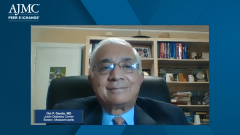
Standard of Care and Guidelines for Cardiorenal Metabolic Syndrome
Nihar R. Desai, MD, MPH, and Om P. Ganda, MD, provide an overview of the standard of care treatments and the collaboration across clinical guidelines to manage cardiorenal metabolic syndrome.
Episodes in this series

Neil Minkoff, MD: Let’s switch gears because this has come up a couple times already. I’d like to start thinking about how we end up treating these patients because there has been data emerging about the SGLT2s [sodium-glucose cotransporter-2 inhibitors]. Even from those of us on the payer lens, it’s an awakening to them being more multifaceted than maybe what we originally thought in diabetes. Nihar, could you say what the standard of care is, or at least what some of the common care paradigms are so we can explore those and look at SGLT2s as well?
Nihar R. Desai, MD, MPH: On the cardiorenal side, the patient that has heart failure is hospitalized and has a rise in their creatinine at this so-called cardiorenal syndrome that Dr Turner started portraying for us. The mainstay of treatment was around volume optimization, optimizing cardiac performance, maybe with ACE [angiotensin-converting enzyme] inhibitors and ARBs [angiotensin II receptor blockers] and ARNIs [angiotensin receptor-neprilysin inhibitors]—though those can cause a transient rise in creatinine but then are renal-protective in the long-term. There’s a number of experimental therapies that are in the works or under investigation right now for cardiorenal.
On the cardiometabolic side, it’s been interesting. Dr Ganda was walking us through some of the history, but it’s been a transformation in the way that we think about cardiometabolic risk. For a condition that’s defined by an abnormality in blood glucose or an elevation of hemoglobin A1C, it’s important for the audience to recognize that trials that have looked at aggressive or tight glycemic control have failed to demonstrate improvements in macrovascular outcomes. There’s never been an improvement in cardiovascular outcomes with tight glycemic control. There are benefits on microvascular events, on renal dysfunction, neuropathy, nephropathy; on the macrovascular events—the events that lead to a lot of both morbidity and mortality for patients with metabolic disease, including diabetes—there’s never been a benefit.
We get to the SGLT2s and the GLP-1s [glucagon-like peptide-1 receptor agonists], and these newer therapies that have relatively modest effects, especially the SGLT2 inhibitors—modest effects on hemoglobin A1C but profound effects in terms of cardiovascular risk reduction, reduction in heart failure hospitalization, and reductions and improvements in cardiorenal outcomes. We’ve come to this moment where we’ve had to rethink cardiorenal and cardiometabolic risk. How do we deploy these interventions and these therapies that seem to offer a lot of clinical benefit and bring a lot of value to these patients?
Neil Minkoff, MD: One of the things we love are guidelines. We love guidelines. We like to know that what’s being done is consistent with the guidelines because to us, that’s the gold standard. The issue is the experts are often practicing medicine one step beyond the guidelines because that’s the route of progress. Having said that, we love ACC [American College of Cardiology] guidelines on the payer side because they’re so prescriptive. First you do this, and then you do this, and then you add that. We love that. I’ll put Dr Ganda on the spot. How do the guidelines deal with the fact that collaboration across these specialties is new? How do they work together, going back to the idea that some of the treatments might be counterintuitive?
Om P. Ganda, MD: Guidelines are meant to be a generalization of the approach to the patient and treatment involving various aspects of a comorbidity. Most of the guidelines have much more in common than you’d think, whether you look at the ADA [American Diabetes Association] EASD [European Association for the Study of Diabetes] guidelines, which are extremely popular, or the ACC and ADA that came together. They have done 2 of these versions by now. There’s ESC [European Society of Cardiology] and other guidelines, including the KDIGO [Kidney Disease: Improving Global Outcomes], the international kidney guidelines, which are really very similar to what has been updated in the ADA EASD guidelines. That’s considered by most as the “Bible.” When it comes to individual patient, one has to realize and accept that there is no set guideline. Considering how much we have accomplished in our treatment approaches, as Dr Desai was saying, there’s not just glycemic treatment. We now have drugs that work regardless of the glycemic control, regardless of the first drug we ever used in diabetes called metformin, regardless of the A1C level achieved, and regardless of whether or not there are other factors. You can think about other drugs on board in a patient at baseline. These drugs work in the presence of all the other drugs that people are on, and they were on state-of-the-art standard of care treatment. That’s how randomized control trials are done these days, yet we learn that these 2 groups of agents, SGLT2 inhibitors and GLP-1 receptor agonists, are by far superior when it comes to cardiovascular disease, heart failure, or CKD [chronic kidney disease] progression.
That’s why all of these guidelines suggest that when you look at a patient who comes to you with diabetes, we need to ask whether this patient has either cardiovascular disease or a high risk of cardiovascular disease. Let’s say 20% in 10 years by the risk equations. That’s the first question you ask. Does this patient have no kidney disease, which we didn’t think to ask 5 years ago? Now we have abundant evidence with at least 1 class of agents—SGLT2 inhibitors. We’re beginning to look at SGLT2s and GLP-1 receptor agonists: how much they have in common, how much they may differ from. Should we be combining them in a patient, and why not? They may have something to offer in such a patient who is highly complicated, especially a younger person. I didn’t want to go into detail, but we now know that, for example, diabetes is occurring in younger and younger people. There’s data from Europe, Scandinavia, and other places that show the younger you are when you develop type 2 diabetes, the greater the risk is of developing complications in 10 years. Even after you adjust for all the risk factors, younger people seem to have a greater insert on their cardiovascular system. This is becoming a very hot topic these days to discuss.
Transcript edited for clarity.
Newsletter
Stay ahead of policy, cost, and value—subscribe to AJMC for expert insights at the intersection of clinical care and health economics.







































